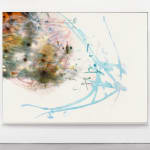-
Artworks



 Installation view, "Chaos and Awe: Painting for the 21st Century," Frist Museum of Art, Nashville, TN, June 22 - September 16, 2018
Installation view, "Chaos and Awe: Painting for the 21st Century," Frist Museum of Art, Nashville, TN, June 22 - September 16, 2018

A bridge, a gate, an ocean, 2014
Oil and ink on canvasFramed: 94 x 120 x 2 1/2 in.
238.8 x 304.8 x 6.3 cm$ 200,000.00Further images
Matthew Ritchie’s 'A bridge, a gate, an ocean,' 2014, reflects the artist’s long-standing investigation into the abstract forms of informational exchange. The richly layered painted surface is presented as a...Matthew Ritchie’s "A bridge, a gate, an ocean," 2014, reflects the artist’s long-standing investigation into the abstract forms of informational exchange. The richly layered painted surface is presented as a place where information and visual experimentation collide, conflating representation and abstraction into a fictionalized space. Within these luminous and spectral passages, figures, diagrams, and thoughts seem to emerge from and collapse into a topology of knowledge. The dense mark making at its center crumples in on itself. Overlaid upon this passage is a bold blue gesture, the artist’s version of Einstein’s Theory of Relativity. Layered atop are a series of small calligraphic marks, Ritchie’s reflection on the very first petroglyphs, which primordial people drew while attempting to trace the universe on a cave wall.
Matthew Ritchie writes, “The universe is an infinitely radiant abyss, eternally emitting information on every frequency. Facing such a comprehensive reordering of our limits, we need to reset our perceptual frameworks at every level.”Exhibitions
Frist Art Museum, Chaos and Awe: Painting for the 21st Century, June 22 - September 16, 2018
Andrea Rosen Gallery, Matthew Ritchie: Ten Possible Links, September 12 - October 22, 2014
Literature
Scala, Mark, ed., Chaos and Awe: Painting for the 21st Century, Cambridge: MIT Press, 2018









